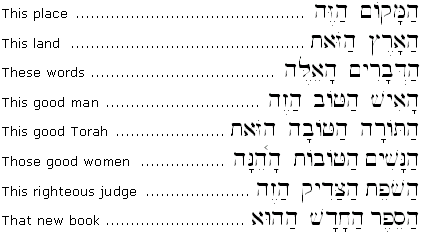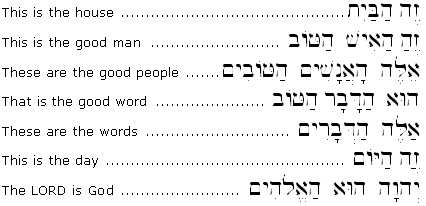|
Introduction to Demonstrative Adjectives
In English, a demonstrative adjective answers the question "which?" by directly pointing to a noun or pronoun. For example:
This dog is sleeping. (singular) ["This" directly points at the dog.]
These dogs are sleeping. (plural) ["These" directly points at the dogs.]
and
That dog is barking. (singular) ["That" directly points at the dog.]
Those dogs are barking. (plural) ["Those" directly points at the dogs.]
The first pair (this-these) points to something near at hand, whereas the second pair (that-those) points to something relatively distant or remote from the speaker:

Note: the definite article is actually a form of demonstrative adjective, since it likewise points to the object. E.g., compare: "a dog" with "the dog."
In Hebrew, demonstrative adjectives function in much the same way as they do in English. Moreover, they follow the same basic usage rules for adjectives that you have already learned.
Hebrew Demonstrative Paradigms
Here is the paradigm for the "this-these" pair:

(Note that the plural form is the same for both genders.)
And here is the paradigm for the "that- those" pair:

(These forms are identical to third-person personal pronouns which we will study in
Unit 6.2. Note that the plural for both genders take two different forms.)
Usage of Demonstrative Adjectives
Demonstrative adjectives follow the same rules as other adjectives, and can be used either attributively or predicatively.
1. Attributive Usage
When a demonstrative adjective is used to directly modify a noun, it is said to be used attributively. A noun with an attributive adjective is said to comprise an adjective phrase (for example, this man, where the adjective this modifies the noun man and the two words comprise a phrase).
Attributive adjectives have the following properties:
- They follow the noun they modify
- They agree with the noun they modify in:
- Gender (masc / fem)
- Number (sing / pl)
- Definiteness (if the noun is definite, the adjective must be, too)
Examples:


In these examples, notice how the demonstrative adjectives appear after their nouns with which they agree in gender, number, and definiteness. In each case the adjective is being used attributively.
Other Examples:

Notice especially that a demonstrative adjective will occur after any other attributive adjectives that might modify the noun in a phrase (for example, in the phrase ha-ish hattov hazzeh, the demonstrative adjective appears after the adjective hattov.)
2. Predicate Usage (Demonstrative Pronouns)
Recall that predicate adjectives have the following properties:
- They appear before the noun they modify
- They agree with the noun they modify in:
- Gender (masc / fem)
- Number (sing / pl)
- but not in definiteness
When a demonstrative adjective functions this way, it is actually behaving substantively as a pronoun (which we call a demonstrative pronoun).
Examples:


In these examples, notice how the demonstrative pronouns appear before their nouns with which they agree in gender, number -- but not in definiteness.
Other Examples:

Notice that a demonstrative pronoun appears before any other attributive adjectives that might modify the noun in an adjective phrase (for example, in the phrase zeh ha-ish hattov, the demonstrative pronoun appears before the entire adjective phrase).

Section Exercises
- Memorize the section vocabulary (top of the page).
- Summarize the usage of demonstrative adjectives on a small flashcard.
- Write some simple examples to help you remember the rules.
- From the vocabulary you already know, create simple constructions using the demonstrative adjectives and pronouns.
<< Return
|













